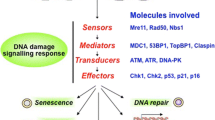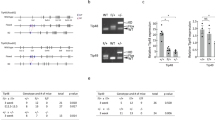Abstract
The NTP-dependent DExH/D-box helicase DHX9 is a key participant in a number of gene regulatory steps, including transcriptional, translational, and microRNA-mediated control, DNA replication and maintenance of genomic stability. DHX9 has also been implicated in tumor cell maintenance and drug response. Here we report that inhibition of DHX9 expression is lethal to human cancer cell lines and murine Eμ−Myc lymphomas. Using a novel conditional shDHX9 mouse model, we demonstrate that sustained and prolonged (6 months) suppression of DHX9 does not result in any deleterious effects at the organismal level. Body weight, blood biochemistry and histology of various tissues were comparable to control mice. Global gene expression profiling revealed that, although reduction of DHX9 expression resulted in multiple transcriptome changes, these were relatively benign and did not lead to any discernible phenotype. Our results demonstrate a robust tolerance for systemic DHX9 suppression in vivo and support the targeting of DHX9 as an effective and specific chemotherapeutic approach.







Similar content being viewed by others
References
Zhang S, Grosse F . Nuclear DNA helicase II unwinds both DNA and RNA. Biochemistry 1994; 33: 3906–3912.
Jain A, Bacolla A, Chakraborty P, Grosse F, Vasquez KM . Human DHX9 helicase unwinds triple-helical DNA structures. Biochemistry 2010; 49: 6992–6999.
Zhang SS, Grosse F . Purification and characterization of two DNA helicases from calf thymus nuclei. J Biol Chem 1991; 266: 20483–20490.
Lee CG, Hurwitz J . A new RNA helicase isolated from HeLa cells that catalytically translocates in the 3' to 5' direction. J Biol Chem 1992; 267: 4398–4407.
Lee CG, Hurwitz J . Human RNA helicase A is homologous to the maleless protein of Drosophila. J Biol Chem 1993; 268: 16822–16830.
Wilson R, Ainscough R, Anderson K, Baynes C, Berks M, Bonfield J et al. 2.2 Mb of contiguous nucleotide sequence from chromosome III of C. elegans. Nature 1994; 368: 32–38.
Zhang S, Grosse F . Domain structure of human nuclear DNA helicase II (RNA helicase A). J Biol Chem 1997; 272: 11487–11494.
Nakajima T, Uchida C, Anderson SF, Lee CG, Hurwitz J, Parvin JD et al. RNA helicase A mediates association of CBP with RNA polymerase II. Cell 1997; 90: 1107–1112.
Anderson SF, Schlegel BP, Nakajima T, Wolpin ES, Parvin JD . BRCA1 protein is linked to the RNA polymerase II holoenzyme complex via RNA helicase A. Nat Genet 1998; 19: 254–256.
Huo L, Wang YN, Xia W, Hsu SC, Lai CC, Li LY et al. RNA helicase A is a DNA-binding partner for EGFR-mediated transcriptional activation in the nucleus. PNAS USA 2010; 107: 16125–16130.
Tetsuka T, Uranishi H, Sanda T, Asamitsu K, Yang JP, Wong-Staal F et al. RNA helicase A interacts with nuclear factor kappaB p65 and functions as a transcriptional coactivator. Eur J Biochem 2004; 271: 3741–3751.
Hartman T, Qian S, Bolinger C, Fernandez S, Schoenberg D, Boris-Lawrie K . RNA helicase A is necessary for translation of selected messenger RNAs. Nat Struct Mol Biol 2006; 13: 509–516.
Manojlovic Z, Stefanovic B . A novel role of RNA helicase A in regulation of translation of type I collagen mRNAs. RNA 2012; 18: 321–334.
Robb GB, Rana TM . RNA helicase A interacts with RISC in human cells and functions in RISC loading. Mol Cell 2007; 26: 523–537.
Tang H, Gaietta GM, Fischer WH, Ellisman MH, Wong-Staal F . A cellular cofactor for the constitutive transport element of type D retrovirus. Science 1997; 276: 1412–1415.
Zhang S, Schlott B, Gorlach M, Grosse F . DNA-dependent protein kinase (DNA-PK) phosphorylates nuclear DNA helicase II/RNA helicase A and hnRNP proteins in an RNA-dependent manner. Nucleic Acids Res 2004; 32: 1–10.
Jain A, Bacolla A, Del Mundo IM, Zhao J, Wang G, Vasquez KM . DHX9 helicase is involved in preventing genomic instability induced by alternatively structured DNA in human cells. Nucleic Acids Res 2013; 41: 10345–10357.
Chakraborty P, Grosse F . Human DHX9 helicase preferentially unwinds RNA-containing displacement loops (R-loops) and G-quadruplexes. DNA Repair (Amst) 2011; 10: 654–665.
Mills JR, Malina A, Lee T, Di Paola D, Larsson O, Miething C et al. RNAi screening uncovers Dhx9 as a modifier of ABT-737 resistance in an Eμ-myc/Bcl-2 mouse model. Blood 2013; 121: 3402–3412.
Lee T, Di Paola D, Malina A, Mills JR, Kreps A, Grosse F et al. Suppression of the DHX9 helicase induces premature senescence in human diploid fibroblasts in a p53-dependent manner. J Biol Chem 2014; 289: 22798–22814.
Lin CJ, Nasr Z, Premsrirut PK, Porco JA Jr, Hippo Y, Lowe SW et al. Targeting synthetic lethal interactions between Myc and the eIF4F complex impedes tumorigenesis. Cell Rep 2012; 1: 325–333.
Premsrirut PK, Dow LE, Kim SY, Camiolo M, Malone CD, Miething C et al. A rapid and scalable system for studying gene function in mice using conditional RNA interference. Cell 2011; 145: 145–158.
Hui L, Zheng Y, Yan Y, Bargonetti J, Foster DA . Mutant p53 in MDA-MB-231 breast cancer cells is stabilized by elevated phospholipase D activity and contributes to survival signals generated by phospholipase D. Oncogene 2006; 25: 7305–7310.
Hoppe-Seyler F, Butz K . Repression of endogenous p53 transactivation function in HeLa cervical carcinoma cells by human papillomavirus type 16 E6, human mdm-2, and mutant p53. J Virol 1993; 67: 3111–3117.
Robert F, Roman W, Bramoulle A, Fellmann C, Roulston A, Shustik C et al. Translation initiation factor eIF4F modifies the dexamethasone response in multiple myeloma. PNAS USA 2014; 111: 13421–13426.
Wendel HG, De Stanchina E, Fridman JS, Malina A, Ray S, Kogan S et al. Survival signalling by Akt and eIF4E in oncogenesis and cancer therapy. Nature 2004; 428: 332–337.
McJunkin K, Mazurek A, Premsrirut PK, Zuber J, Dow LE, Simon J et al. Reversible suppression of an essential gene in adult mice using transgenic RNA interference. PNAS USA 2011; 108: 7113–7118.
Zuber J, McJunkin K, Fellmann C, Dow LE, Taylor MJ, Hannon GJ et al. Toolkit for evaluating genes required for proliferation and survival using tetracycline-regulated RNAi. Nat Biotechnol 2011; 29: 79–83.
Tang H, McDonald D, Middlesworth T, Hope TJ, Wong-Staal F . The carboxyl terminus of RNA helicase A contains a bidirectional nuclear transport domain. Mol Cell Biol 1999; 19: 3540–3550.
Calcabrini A, Garcia-Martinez JM, Gonzalez L, Tendero MJ, Ortuno MT, Crateri P et al. Inhibition of proliferation and induction of apoptosis in human breast cancer cells by lauryl gallate. Carcinogenesis 2006; 27: 1699–1712.
Trudel S, Stewart AK, Li Z, Shu Y, Liang SB, Trieu Y et al. The Bcl-2 family protein inhibitor, ABT-737, has substantial antimyeloma activity and shows synergistic effect with dexamethasone and melphalan. Clin Cancer Res 2007; 13: 621–629.
Harper JW, Adami GR, Wei N, Keyomarsi K, Elledge SJ . The p21 Cdk-interacting protein Cip1 is a potent inhibitor of G1 cyclin-dependent kinases. Cell 1993; 75: 805–816.
Campisi J, d'Adda di Fagagna F . Cellular senescence: when bad things happen to good cells. Nat Rev Mol Cell Biol 2007; 8: 729–740.
Gartel AL, Tyner AL . The role of the cyclin-dependent kinase inhibitor p21 in apoptosis. Mol Cancer Ther 2002; 1: 639–649.
Tovar C, Rosinski J, Filipovic Z, Higgins B, Kolinsky K, Hilton H et al. Small-molecule MDM2 antagonists reveal aberrant p53 signaling in cancer: implications for therapy. PNAS USA 2006; 103: 1888–1893.
Lee CG, da Costa Soares V, Newberger C, Manova K, Lacy E, Hurwitz J . RNA helicase A is essential for normal gastrulation. PNAS USA 1998; 95: 13709–13713.
Walstrom KM, Schmidt D, Bean CJ, Kelly WG . RNA helicase A is important for germline transcriptional control, proliferation, and meiosis in C. elegans. Mech Dev 2005; 122: 707–720.
Parsyan A, Shahbazian D, Martineau Y, Petroulakis E, Alain T, Larsson O et al. The helicase protein DHX29 promotes translation initiation, cell proliferation, and tumorigenesis. PNAS USA 2009; 106: 22217–22222.
Sonenberg N, Hinnebusch AG . Regulation of translation initiation in eukaryotes: mechanisms and biological targets. Cell 2009; 136: 731–745.
Dardenne E, Pierredon S, Driouch K, Gratadou L, Lacroix-Triki M, Espinoza MP et al. Splicing switch of an epigenetic regulator by RNA helicases promotes tumor-cell invasiveness. Nat Struct Mol Biol 2012; 19: 1139–1146.
Davis BN, Hilyard AC, Lagna G, Hata A . SMAD proteins control DROSHA-mediated microRNA maturation. Nature 2008; 454: 56–61.
Fukuda T, Yamagata K, Fujiyama S, Matsumoto T, Koshida I, Yoshimura K et al. DEAD-box RNA helicase subunits of the Drosha complex are required for processing of rRNA and a subset of microRNAs. Nat Cell Biol 2007; 9: 604–611.
Saporita AJ, Chang HC, Winkeler CL, Apicelli AJ, Kladney RD, Wang J et al. RNA helicase DDX5 is a p53-independent target of ARF that participates in ribosome biogenesis. Cancer Res 2011; 71: 6708–6717.
Mazurek A, Park Y, Miething C, Wilkinson JE, Gillis J, Lowe SW et al. Acquired dependence of acute myeloid leukemia on the DEAD-box RNA helicase DDX5. Cell Rep 2014; 7: 1887–1899.
Soucek L, Whitfield J, Martins CP, Finch AJ, Murphy DJ, Sodir NM et al. Modelling Myc inhibition as a cancer therapy. Nature 2008; 455: 679–683.
Malumbres M, Barbacid M . To cycle or not to cycle: a critical decision in cancer. Nat Rev Cancer 2001; 1: 222–231.
Barde I, Salmon P, Trono D . Production and titration of lentiviral vectors. Curr Protoc Neurosci 2010 (Chapter 4): Unit 4.21.
Acknowledgements
We thank Francis Robert for performing tail-vein injections of lymphoma cells into mice. TL was supported by a Maysie MacSporran graduate studentship and fellowships from the CIHR-sponsored Chemical Biology and Systems Biology Training Programs. This work is supported by grants from the Canadian Cancer Society Research Institute (no. 701362) and National Institutes of Health (CA163291) to JP and grants from the Swedish Research Council and the Swedish Cancer Society to OL.
Author contributions
TL performed all experiments under the guidance of JP. MP provided the histopathological analysis of tissue sections. OL analyzed the gene expression data. TL and JP wrote the manuscript.
Author information
Authors and Affiliations
Corresponding author
Ethics declarations
Competing interests
The authors declare no conflict of interest.
Additional information
Supplementary Information accompanies this paper on the Oncogene website
Supplementary information
Rights and permissions
About this article
Cite this article
Lee, T., Paquet, M., Larsson, O. et al. Tumor cell survival dependence on the DHX9 DExH-box helicase. Oncogene 35, 5093–5105 (2016). https://doi.org/10.1038/onc.2016.52
Received:
Revised:
Accepted:
Published:
Issue Date:
DOI: https://doi.org/10.1038/onc.2016.52
- Springer Nature Limited
This article is cited by
-
The DNA/RNA helicase DHX9 orchestrates the KDM2B-mediated transcriptional regulation of YAP1 in Ewing sarcoma
Oncogene (2024)
-
The DNA/RNA helicase DHX9 contributes to the transcriptional program of the androgen receptor in prostate cancer
Journal of Experimental & Clinical Cancer Research (2022)
-
DHX9 contributes to the malignant phenotypes of colorectal cancer via activating NF-κB signaling pathway
Cellular and Molecular Life Sciences (2021)
-
A DHX9-lncRNA-MDM2 interaction regulates cell invasion and angiogenesis of cervical cancer
Cell Death & Differentiation (2019)
-
Suppression of Transposable Elements in Leukemic Stem Cells
Scientific Reports (2017)




